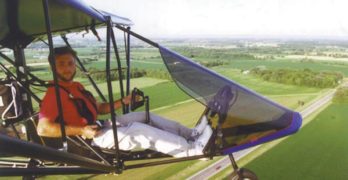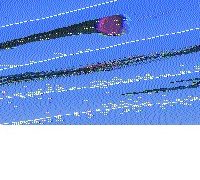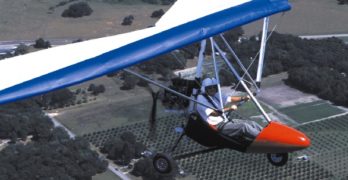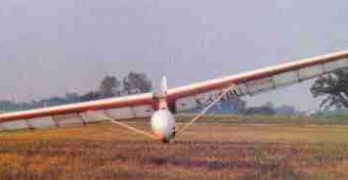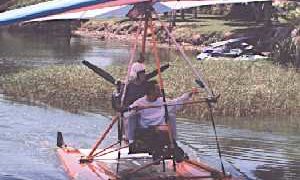Manufacturers in the ultralight industry believe they know what pilots want or what they will buy, anyway. A 2-seater is usually part of the answer. But, in fact, many industry watchers are wrong.
While many observers make the statement, ÒNinety percent of ultralights are 2-seaters,Ó statistics tell another story. Nearly 40% of ultralight and microlight aircraft sold in the U.S. are single-seaters, according to Ultralight Flying! magazineÕs surveys of manufacturers. Despite the polling results, however, those experts have a point. Two-seaters do represent the majority of ultralights and microlights sold.
Yet, just when you think 2-seaters are going to take over the whole market, along comes a new trend. Maybe it was FAAÕs lack of action on Part 103 changes, or maybe manufacturers simply decided to take on the challenge of staying within 103Õs tight weight, speed and fuel quantity restrictions. Whatever the correct answer, it doesnÕt change the fact of a growing population of Part 103 ultralights.
Search Results for : trikes
Not finding exactly what you expected? Try our advanced search option.
Select a manufacturer to go straight to all our content about that manufacturer.
Select an aircraft model to go straight to all our content about that model.
Convertible Buckeye
In a calculated move planned for over a year, powered parachute leader Buckeye Industries introduced their new trike line at AirVenture ’98. This marks two points of interest to EXPERIMENTER readers.
The first point is a significant entry to the trike market, a segment of ultralight aircraft that has finally shown real growth potential after many years of effort by trike makers. Though European companies threw open the door with persistent marketing efforts mimicked by a few Yankee builders, Buckeye’s entry to the field could increase the number of trikes sold by a good margin.
Secondly, as a widely acknowledged sales leader among powered parachute builders, Buckeye is making something of a statement to that community of aviation enthusiasts. Powered parachutes deserve a follow-on aircraft and Buckeye has decided (logically, to my view) to make that successor a trike.
And, Why Not?
If you owned Buckeye and already made a slick, wheeled carriage for your powered parachutes, wouldn’t you also leverage that design to work for a trike?
Built for two
After ten years of producing exclusively single seaters, Tennessee-based TEAM Aircraft broke with tradition and rolled out their very first two seater, the Tandem Air-Bike, at Sun ‘n Fun ’96, following the company’s successful Air-Bike design debuted two years earlier.
Wayne Ison’s TEAM got a lot of attention from the Air-Bike – it being regarded as an aircraft you get on, not in. That same sporty, fun-to-fly concept has now stretched into a two-seat model.
Some buyers will use the Airbike Tandem for instruction under the training exemption to Part 103. Others will N-number the machine and use it for the occasional joy ride with a passenger. It should work well either way. In fact, the close-quarters tandem seating means that when the aircraft is flown solo, it should perform well and yet feel more like the agile single seater than some other designs. This theory has worked well for Kolb and their Firefly II, for example.
Facing the buying decision
What Kind of Pilot Are You?
Let’s just say you actually know yourself. While this sounds like a comment that deserves a “duh!” response, don’t be too quick to judge. If every pilot or buyer of an aircraft knew what he/she needed or wanted, my job would be easier. But it isn’t so. Most pilots know something about what they want, but many don’t have enough information to make the best decision.
Some readers are “experts.” A good many ultralight or light plane enthusiasts have been around long enough and owned enough of a variety of ultralights to know what they like. These veteran sport aviators represent a lot of combined experience. If you’re new to ultralight flying, I strongly encourage you to seek out local experts. They can be your very best source of information because they know you. (However, as I reminded you last time, remember that anybody selling any aircraft – whether their own or one they represent – has a bias that you must not overlook.
Welcome to Kitplanes
Updated: 7 December 2001
If you like hang gliding…
then you have come to the right page. Currently, the Website has several Dennis Pagen pilot reports of the most popular hang gliders. (Thanks to Dennis for working me to bring you his fine reports.)
I also have posted the last few Product Lines columns from Hang Gliding magazine. This column has run every month for the last 22 years and therefore represents a significant historical record for the sport of hang gliding. I will add the newest versions each month and will go back and add the older ones on a steady basis.
Powered Hang Gliding & Soaring
Those hang glider pilots willing to add engines to the equation will find some pilot reports on light trikes. These are machines I have flown that can deliver soaring flight to hang gliding enthusiasts. Some are better than others. well, that may be why you visited this site — to see the differences.
Polaris Slip
Here’s Polar Star’s entry in the minitrike sweepstakes.
You probably know Polaris even if you aren’t aware of the company name. Odds are good you’ve seen a picture of the Polaris inflatable flying boat. This is a trike with a small boat built around a steel trike frame. It looks unusual and remains unique.
Polaris claims to have shipped over 600 of these flying inflatable boats, once known as the Air Dinghy. The company reports these are flying around the world, owned by tourist resorts, Navy and police departments, Greenpeace ships, yacht owners, research marine institutions, and private pilots.
The company originated in Italy but opened an American office after founder, Doi Malingri, retired in Florida. Along with several Americans including Dave Melillo and Vince Kaufman, Malingri has established a U.S distribution center called Polar Star Group, a division of Polaris Motor.
Established in 1982, Polaris is experienced in aircraft manufacturing.
Foxbat
Manta’s Foxbat is the original rigid-wing trike.
A few months ago here, I revealed what I believe will be a new trend among trike ultralights: the rigid-wing trike. This machine will take the increasingly popular trike concept into the 21st century by using a composite wing of very high aspect ratio. Such a wing brings increased performance and promises dramatically better handling than can be found on the so-called flex-wing trikes that presently do the heavy lifting on trikes.
Only time will tell if my prediction is right. Yet years-perhaps decades before these rigid wings become common, an Oakland, California, company produced a rigid wing trike of its own. Foxbat was the name. That it did not achieve great market success is no condemnation of the trike or its then-unorthodox wing.
In fact, Pterodactyl, which did achieve good sales, used this identical wing as its starting point for the company’s much more popular line of ultralights.
Marske Sailplanes
The Marske Monarch continues to offer economical soaring.
Ultralight sailplanes. Are they a new category of aviation, a segment of ultralight aircraft or just little sailplanes? Though ultralights seem to be some of the newer aircraft in general aviation, their true lineage is based on soaring machines.
For example, the first and still most successful ultralights, the Quicksilver series, came from a hang glider design to which a small engine was added back in the 1970s. Trikes, which have continued to grow in worldwide popularity, are based on delta-wing hang gliders to which power and landing gear were added. Therefore, though the term may be relatively new (going back a decade or so), the aircraft has a longer heritage. One shining example of this is Jim Marske’s Monarch.
New Model, Old Design
Marske has been building the Monarch for 20 years and has added his higher performance model, the Pioneer, to his list of designs spanning 40 years.
Buggy on Floats
Float-Equipped Air Création Trike
Trikes and floats offer the same fun potential as do floats on most ultralights. But they offer more challenge to make it work.
First of all, trikes leave the ground differently than most 3-axis ultralights. When the wing takes off, the chassis swings into place underneath it, pivoting forward several inches of displacement. While this makes landings easy (the main gear contacts earth first), this shift requires float fitting to be well-considered.
Then, you must develop a water rudder system, which isn’t particularly challenging except to keep everything light. Without such a system, a trike cannot be maneuvered in the water, unlike a rudder airplane which can steer by propblast against the rudder. The standard steering pedals are used in the same push- right go-left method of ground steering a trike.
I once tried to water taxi a trike (for a photo shoot of all things) back in the early ’80s, before water rudders had been developed for trikes.
- « Previous Page
- 1
- …
- 32
- 33
- 34


